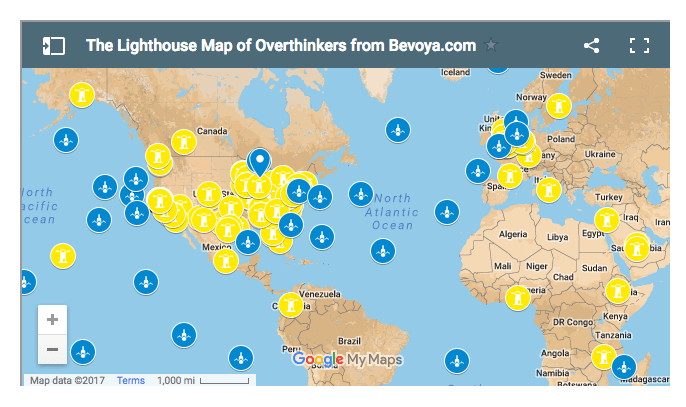The Day I Learned I Had Anxiety

…And what happened in the following months and years.
In 2015, my life looked textbook-charmed. I’d lived in San Francisco for 12 years — long enough to understand its ups and downs — and worked in tech nearly as long. I had a thoughtful, handsome husband and a wise, funny, five-year-old daughter.
This is what life felt like:
Nearly daily migraines, crippling neck and shoulder pain, and a nauseated stomach that sometimes forced me off the bus to keep me from fainting.
I’d given up much earlier on the hope of finding a cause for these pains, so in July 2015 I went to my annual neurologist appointment ready for dose of confused irresolution. Instead, in response to my hyper-focused research and fast speaking, she diagnosed me with generalized anxiety disorder. My life changed on the spot.
Why had this diagnosis been so elusive?
Generalized anxiety is an umbrella term, meaning that there are lots of different types of people to be found under there when it rains.
The statistics shared on ADAA suggest that 6.8 million Americans, or a little over 3% of the population, has generalized anxiety disorder. (I think that’s massively understated, incidentally).
I believe that the description of GAD caused me to miss the symptoms I was experiencing. “Excessive worry,” the disorder’s most common descriptor, was problematic for me. For 39 years, I didn’t consider myself a worrier.
I was an overthinker with migraines
Since I never used the words or mindset that the health industry used, I found very few examples that rang true when I searched for information about generalized anxiety. Even after my diagnosis, and acceptance of diagnosis (which was lightning fast, btw. As soon as my neurologist said the words, I knew she was right), I had a terrible time finding relevant information about GAD. In person and online, though, I met tons of people who were, in fact, just like me: men and women experiencing physical pain resulting from perfectionism, fear of failure, and overthinking.
The disconnect between how people talk about anxiety and what anxiety actually feels like is what drives me to write and talk about anxiety. Thanks to my diagnosis, what was once invisible now has shape, and I understand the world around me differently.
Was My Experience Unusual?
A few months after going on anti-anxiety medication, I went back to my neurologist at UCSF and explained that my once-daily headaches were now down to one per month. I was grateful. I was also curious to know if my experience was unusual. From what I could tell, it seemed surprisingly common.
But—cue the overthinking—maybe I was overestimating it. Like every good student of anxiety, I had memorized my list of cognitive biases. Was I overgeneralizing? Was my sense that people around me were experiencing physical pain as a result of perfectionism simply projecting my problem onto others?
Was I hearing only what fit my story?
My neurologist listened to my concerns and then replied, “This problem — the problem of perfectionism and anxiety — is getting bigger and bigger every day.”
She described seeing an average of three people a day suffering from some form of chronic physical pain who had one thing in common: perfectionism.
“It’s extremely common in the tech industry,” she said. “These people are very successful. They want to do everything right.” She then said something haunting: “One of the groups that has the hardest time seeing GAD in themselves is psychiatrists and psychologists.”
Diagnosis is hard
In the past, if you had a physical problem, you’d visit a doctor.
If you were having a mental problem, you’d visit an office like this:
Treating symptoms meant sitting in a room with an expert, looking for answers together.
If your physical symptoms spring from your intense pursuit of perfectionism, however, this method is problematic. You can visit doctors of all stripes, and they won’t find anything physically wrong with you. Therapists may enjoy your confessional insights and wit as much as you enjoy sharing them—but they won’t help you when your back gives out again.
It’s Up to You to Connect the Dots
Anxiety, though chemically and genetically influenced, is, at its most fundamental, a system of messages the body is trying to send the mind. It’s similar to an allergic reaction where the body overreacts to stimuli. In this case, the fear of losing control causes an adrenalin and cortisol rush in the body. Our minds work to avoid negative feelings (or the stimuli that caused it). Yet the effort of avoidance ends up creating more fear—and more overreaction. Doctors have long seen a connection between the physical pain that people feel and the emotions they are repressing.
For perfectionists, the mind is trying to tell itself the truth: “I can’t live up to my own expectations.” But inherent in the perfectionist problem is an inability to accept this reality. The mind deflects the message of impossible expectations and literally pushes it into the body.
My neighbor is an example of this. Let’s call him Shane. Shane is an artist and teacher who spends a lot of time worried about what other people think about him. His standards for work are extremely high.
He also has a lot of neck and back pain, sudden bouts of sweating, and dizziness. He takes 3–4 ibuprofen a night for “sore muscles.” He needs a whiskey to help him fall asleep.
He knows that he has anxiety, but hasn’t yet figured out how to listen to what his body is telling him, or how to address the pain.
When I learned about my generalized anxiety disorder, I started with the treatment path of medication (Lexapro, 10 mg every day), meditation (Headspace, 20 min every day), and communication (writing, talking, all the ways). Treating perfectionism meant I’ve been forced to stop comparing myself to other people, especially on social media. I’ve had to learn how to turn up the volume on my own voice of confidence and creativity. I did this by creating a project that looks at perfectionism from a bird’s eye view.
Beautiful Voyager was born
Since late 2015, I’ve been working to create a place for perfectionists to meet and learn stress relieving techniques from each other. It’s called The Beautiful Voyager.
My goal with the site was to create a space where it was OK to be imperfect. I threw my real, far-from-perfect self, out into the world for everyone to see, hoping that other people like me might find comfort and common cause in my struggle. It’s like training wheels for social interactions. As confidence builds, pain subsides.
The Only Map is Buried Deep
I used to think, “There’s no map to understanding anxiety.” But that’s not true. There is a map. It’s just that each person’s is unique and buried deep inside of them. It takes a long time to navigate your own internal terrain. I created the site because it helps to have other navigators around during the map-hunting process.
If you or someone you love is experiencing symptoms like those on this list from my neurologist, take a closer look at how anxiety isn’t always what it seems.
- migraines
- dizziness
- nausea
- back pain
- neck pain
- tingling
- chest pressure
- palpitations
- light-headedness
This is one epidemic we can do something about, but we have to work together. So as you go out into the world, or deep into the world within, in search of the map you need, know that you’re not alone.
I’ll meet you there.











